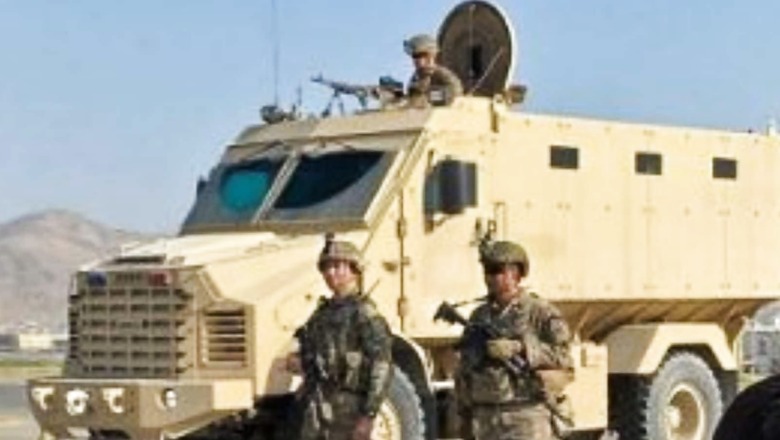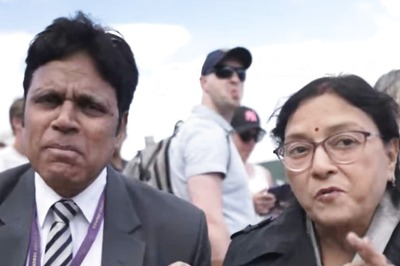
views
The US war on Afghanistan in the aftermath of 9/11 was backed by the largest and most all-encompassing international support ever rallied behind a state going into conflict. The shocking images from New York and Washington D.C. in 2001 gave the US unprecedented access to this international support, so much so that even states such as Iran latently backed US in its ‘war against terror’ narrative. All that capital the US built behind it, from NATO to even China, is getting eroded on an hourly basis today as the Taliban close in on the capital city of Kabul.
On July 8, President Joe Biden had said that a Taliban takeover of Afghanistan was not inevitable. “The Afghan troops have 300,000 well equipped—as well equipped as any army in the world—and an air force against something like 75,000 Taliban. It is not inevitable,” he said. Biden went on to say he did not trust the Taliban, but trusted a better trained, equipped, and competent Afghan military. Fast forward to August, mere weeks after Biden’s comments, the Afghan military has surrendered or evacuated their positions against the Taliban at an unprecedented pace. Visuals of well-armed Afghan soldiers equipped with American-made Humvee and ATF vehicles driving out of cities without an inch of visible resistance as groups of Taliban insurgents, on foot, merely armed with Kalashnikovs and whatever other weapons they could salvage from abandoned bases, waltz into towns and take an entire population of men, women, and children back to the dark ages flooded the internet. One report even highlighted that the Afghan troops had also fallen for Taliban spread rumours that the Afghan government, leaders of the ANSF, had made a deal with the Taliban to hand over control of portions of the country. “Brother, if no one else fights, why should I fight?”, an Afghan soldier was quoted as saying to his commander in Kunduz.
The reaction of the Biden administration till now has been of gross indifference, ambivalence, and only to send in troops to help their own diplomats and citizens escape. Meanwhile, the architects of this mess, such as Chief Negotiator Ambassador Zalmay Khalilzad, who frequently sold the very idea of a reformed Taliban, are reportedly trying to incentivise the group even further, for the mere request of allowing the US embassy to function safely.
Strategic blunders aside, serious questions have been raised over the information that is being forwarded to Biden and then quoted by him later about the prowess of the Afghan military. The reality on the ground in Afghanistan today, where the Taliban managed to take over 17 provincial cities and towns over just 120 hours, including Kandahar and Herat, the second- and third-largest centres after Kabul, is opposite to what the US President publicly highlighted in July. What kind of ‘con’ was perpetrated in Washington D.C. which sold the development of the Afghan military as an institution worthy of protecting Afghans from the likes of the Taliban, only to collapse in days? What happened to the US $83 billion, more than India’s annual defence budget, spent on just training and equipment for the Afghan forces over 20 years? Ultimately, what whispers made it to Biden’s ears that allowed such an unprecedented pull out, throwing roughly 33 million Afghans under the now Taliban-controlled Humvee.
There are many versions and excuses at play today, from inept leadership within the hierarchies of the Afghan National Security Forces (ANSF), highlighted by the overnight removal of the Afghan Army Chief last week, to months of red flags being waved on the capacities of the ANSF without any course correction by the US coming through. There is no doubt that the ANSF itself does not come from a strong background of institution building, suffering from critical issues such as infiltration by pro-Taliban individuals within the ranks, leading to a phase of ‘green-on-blue’ attacks by ANSF soldiers against their NATO partners to high-level corruption cases such as those of ‘ghost soldiers’, crackdown against which led to a reduction of 42,000 fake personnel in the ANSF in 2019. But this is where the US was highlighting that it was succeeding in building a robust military leadership. Even from pure numbers play, with the narrative of a 300,000 strong ANSF being sufficient thrown around Washington, research conducted by scholars such as Jonathan Schroden has previously highlighted that a broad look around the ANSF’s number strength being enough to defeat the Taliban’s nearly three-decade-long experience of waging insurgency exclusively within the borders of Afghanistan are not good enough odds in favour of Kabul or the US. Schroden earlier this year said: “If the United States were to withdraw the remainder of its forces from Afghanistan, the Taliban would enjoy a slight military advantage that would increase in a compounding manner over time.” Over the past month, this seems to be exactly what has happened, only at a lightning speed.
Today, former diplomats and military officials from the US are bitterly divided over Biden’s decision to withdraw. Former senior military leaders such as John R Allen, who served as the commander of the International Security Assistance Force (ISAF) to Afghanistan between 2011 and 2013 under the administration of President Barack Obama, are now from the outside able to paint a dire picture of what would happen if Kabul fell to the Taliban once again. While Allen paints a realistic and lucid portrait of the crisis Afghanistan is staring into, his views are largely academic on what would happen if Biden did not reverse his decision.
What many like Allen today are failing to provide are assessments and a level of self-reflection, being part of the 20-year war in Afghanistan, as to where did the slip up happen in the institution building of the Afghan military ecosystem. If the withdrawal is a political decision by Biden, the Pentagon has majority equity in a failed blueprint towards building a military architecture for Afghanistan. One that could sustain a withdrawal realistically and practically, not just on paper or balance sheets.
Finally, before the arguments put forward by this piece are turned on their head with possible questions on India’s contribution, it is important to return to the first paragraph of this text for reference. The world rallied behind the US and its counterterrorism strategy after 9/11, including India within its diplomatic and political capacities. A mere three months after the US attacks, the Indian Parliament was struck by terrorists in December 2001 in the heart of the capital New Delhi, leading to several casualties. The groups responsible were Pakistan-based Lashkar-e-Taiba (LeT) and Jaish-e-Mohammed (JeM). Yet, the world still did not rally behind India to aggressively take on terrorism sanctuaries in Pakistan, the same country where almost all the Taliban’s ‘shuras’ openly reside even today, and which leveraged its control over the group to get its way both with Afghanistan and the US.
This article was first published on ORF.
(The views expressed in this article are those of the author and do not represent the stand of this publication.)
Read all the Latest News, Breaking News and Assembly Elections Live Updates here.




















Comments
0 comment